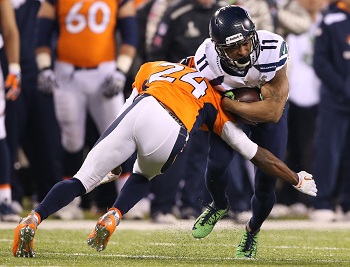An Offseason In Motion For Football On TV

It’s been almost seven months since the Seattle Seahawks demolished the Denver Broncos 43-8 in Super Bowl XLVIII, a lifetime for the millions who call pro football their favorite sport and have made National Football League games the most popular TV programming in America.
For those who prefer the collegiate brand of ball, the wait has been even longer: Heisman Trophy winner Jameis Winston led Florida State on a last-second drive to beat Auburn 34-31 on Jan. 6 and end the Southeastern Conference’s reign as the sport’s champion at seven seasons.
Whether you prefer the pros, the ascendant collegiate game or devote much of your fall and winter weekends to football of any stripe, fresh seasons of pigskin play are about to unfurl in stadiums, living rooms and taverns near you.
New rights deals have already irrevocably altered the TV landscape. College kingpin ESPN has plunked down $470 million per year over 12 years — a total of $5.6 billion — for the rights to a new playoff system that will see four teams vie in semifinal meetings before the winners collide in a game that could draw the largest audience in cable history.
And NFL rights have jumped more than 60% on average. ESPN will present its first-ever NFL playoff game, a Wild Card contest, part of a package for which it will pay $15.2 billion over eight years, or $1.9 billion annually. That’s up from $1.1 billion under the pact that expired with the 2013 season. The playoff game was worth a reported $100 million.
NBC, whose Sunday Night Football has led primetime in viewership the past three years, will sub out a Wild Card game for a divisional matchup. The Peacock, which will also get a chance to benefit from extra flex scheduling early — a pair of games between weeks 5 and 10 can be switched — is now paying $950 million per year from 2014 to 2022, up from $650 million per season under the pact that ended last year.
NBC will culminate the football season with Super Bowl XLIX and a chance to tackle America’s top audience from Fox, which counted a record 111.5 million viewers, despite the Seahawks’ blowout of the Broncos.
The smarter way to stay on top of the multichannel video marketplace. Sign up below.
After registering its most-viewed season ever in 2013 since it began airing the NFL back in 1994, Fox will see the price of its large-market National Football Conference package jump from $712.5 million to $1.1 billion under its new nineyear pact.
Sunday-afternoon brethren CBS averaged 18.7 million viewers last season, its second-best delivery since it has been airing the American Football Conference package. Black Rock, which will get a chance to augment its audience with a number of cross-flex games bringing NFC matches as means of generating greater overall exposure for the league, is now paying $1 billion per year over the next nine seasons, up from $550 million.
In what could be the biggest shakeup in the primetime landscape since cable started seriously eating into broadcast’s Nielsen ratings, CBS is also stepping onto the Thursday Night Football field.
For a reported $275 million in rights fees, the nation’s most-viewed network will air games during the first half of the season that will be simulcast on NFL Network. The back end of the schedule will feature games produced by CBS that will air on NFL Network and broadcast stations in the participating teams’ home markets.
The NFL is looking to gauge just how big a player it can become on one of TV’s most-watched nights of the week and one favored by Madison Avenue and its studio, auto and retail clients. For CBS, whose comedy lineup has been the dominant force on Thursday for years, it means returning TV’s top sitcom, The Big Bang Theory, to its original Mondaynight roots until late October. That could widen its audience advantage overall and give it a leg up on other bidders should the NFL elect to make this hybrid scheduling format a fixture, or it could offer the entire TNF package to a broadcast network.
Meanwhile, despite repeated proclamations from DirecTV that it expects to retain the “NFL Sunday Ticket” out-of-market package, the satellite-TV leader and the league have yet to renew their deal, which is about to enter the final year under which DirecTV pays $1 billion annually. AT&T reportedly has an out clause in its proposed merger with DirecTV if the satellite-TV provider fails to retain the Ticket.
The league is expanding multiscreen options for fans, Brian Rolapp, NFL Media executive vice president, said. NFL Red Zone, the Sunday-afternoon ad hoc scoring and highlights service, is still growing, adding 20 new providers since January. It enters the 2014 campaign with 250 affiliates.
Accessible across Internet-connected devices, new service NFL Now enables users to identify their favorite team, fantasy players and video content preferences. The plan calls for content to personalize each user’s viewing experience to deliver a customizable news, analysis and highlights offering for NFL fans around the globe. Additionally, NFL Now will provide users with access to a vault of on-demand pro-football video content available anywhere.
NFL Now Plus ups the ante — for $1.99 per month, subscribers can check out instant in-game highlights, plus gain access to the complete NFL Films library, including NFL Network staples America’s Game and A Football Life.
And as part of a reported four-year $1 billion renewal, Verizon’s NFL Mobile package will broaden this season, with subscribers gaining access to more streaming content including in-market games on Sunday afternoon.
